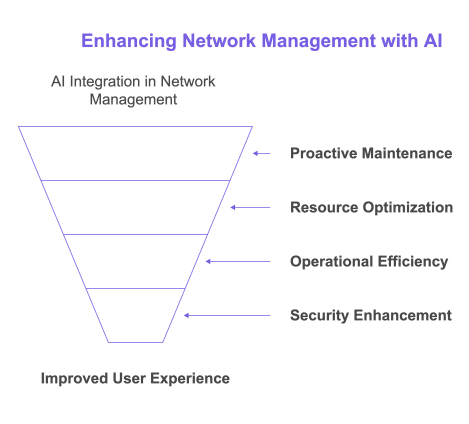As part of today’s fast-paced telecom ecosystem, multiple system operators (MSOs) can turn to artificial intelligence (AI)-based automation to improve network reliability, performance and operations. While not without its challenges, AI automation can drive positive results across several domains, most notably in the arena of customer experience.
Anticipating Failures, Optimizing Resources
Proactive network maintenance (PNM) in cable HFC networks has evolved over time. One turning point some years ago was the use of upstream pre-equalizer coefficients to more accurately detect and localize network impairments. The arrival of AI automation marks a similar inflection point.
By analyzing historical network data, AI can find patterns that predict network failures or performance issues. This data-driven approach lets MSOs take proactive action, reduce unplanned downtime and improve network reliability. AI can also power real-time anomaly detection, constantly looking for unusual traffic patterns. This speeds up incident response and lets operators address vulnerabilities immediately, reduce service disruptions and minimize security risks.
Resource optimization is another applicable domain. AI-driven traffic prioritization, for instance, lets critical apps get the bandwidth they need. By dynamically adjusting resources, these systems optimize Quality of Service (QoS) and keep data flowing smoothly. AI’s predictive capabilities also extend to capacity planning. By looking at historical usage and forecasting future demand, AI helps operators better allocate resources, so they can scale without impacting service or incurring unnecessary costs.
Automated Operations and Security
In terms of operations, AI automation simplifies network ops and improves operational efficiency. By analyzing configurations, for instance, AI can find the optimal settings and automate deployment across network devices. This consistency reduces human error and the time it takes to change configurations.
Advanced AI can go beyond detection and even initiate self-healing actions, fixing issues without human intervention. This reduces Mean Time to Repair (MTTR), keeps networks running and minimizes impact to end users.
Network security also stands to benefit from AI automation. Always-on, AI-powered systems constantly monitor traffic for security threats, learning and adapting to new attack patterns. This improves detection accuracy and response time and makes networks more resilient to emerging cyber threats. When a threat is detected, AI-driven systems can execute pre-defined responses, such as isolating affected network segments. By acting fast, these systems improve threat containment and reduce service disruptions.
Challenges to Implementing AI Automation
As with any new technology, AI-based automation imposes challenges and costs. Such systems may require upfront investment in software, hardware and skilled personnel. While AI can boost threat detection and incident response, collecting vast amounts of data also could pose security risks or raise data privacy concerns if not managed properly.
Specialists may be required to maintain these systems and handle tradeoffs. Given that predictive systems are imperfect, for instance, there needs to be an effort to minimize false positives (which could lead to unnecessary interventions) and false negatives (which result in undetected issues). Some systems, especially those leveraging machine learning (ML) and neural networks, however, are difficult even for experts to explain.
Finally, to the extent that AI automation replaces manual tasks, it may reduce the need for certain roles, leading to job displacement concerns among network maintenance and monitoring staff.

Proofpoint: Better Customer Experience
Notwithstanding such challenges, MSOs should regard AI automation as a net positive. Reducing service disruptions, lower MTTR, improved network reliability and responsiveness, and other benefits mentioned above redound to the ultimate proof point: better customer experience. As customers use cable networks for work, streaming and digital services, stability is more important than ever. Faster resolution means less customer frustration and higher satisfaction and brand loyalty.
AI automation is poised to change network management for MSOs, with significant benefits in reliability, efficiency and security. By using AI for proactive maintenance, resource optimization, operational efficiency and security, operators can deliver a better experience for today’s digital users. As AI improves, it will set an even higher bar for network and customer experience in the cable space.
For information on AOI’s remote management and monitoring solution, check out QuantumLink.
Other Resources From AOI
Quantum18 | 1.8GHz HFC Amplifiers
QuantomLink | Remote Management
Guide to DOCSIS 4.0